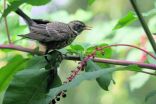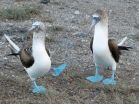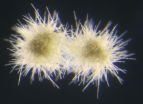(Press-News.org) LEXINGTON, KY. (Apr. 22, 2015) -- It was once thought that effects of a mild head injury -- dizziness, headaches, memory problems -- were only temporary, and the brain would heal over time. However, while the long-term consequences of head trauma are not fully known, growing evidence suggests that even a mild head injury can increase the risk for later-in-life development of dementias such as Alzheimer's disease.
Researchers at the University of Kentucky's Sanders-Brown Center on Aging have been attempting to understand the cascade of events following mild head injury that may lead to an increased risk for developing a progressive degenerative brain disease, and their new study, which was published in the current issue of the Journal of Neuroscience, shows initial promise for a treatment that might interrupt the process that links the two conditions.
"By defining the cascade of events that occurs after a mild brain injury, we ultimately hope to discover ways to disrupt that process," said Adam Bachstetter, PhD, of the Sanders-Brown Center on Aging. "Our goal is to uncover the biology that underlies the link between head injury and dementia, and in our latest research, we think we have found evidence that an altered inflammatory response from cells in the brain called glia may be at least part of the link."
To explore the chain of events that link TBI to increased risk for dementia, Bachstetter and co-author Scott Webster, PhD, of the Sanders-Brown Center on Aging, used a mouse that has been genetically altered to make a human protein called amyloid beta, which is a key player in Alzheimer's disease. The researchers also developed a surgical procedure to mimic the most common form of traumatic brain injury.
"We wanted to know if we could accelerate the onset of memory problems in these mice, similar to what is believed to occur in humans," said Webster. "It gave us a way to ask the important mechanistic questions that might one day lead to a better treatment for head injury patients."
Bachstetter and Webster used a small molecule drug known as MW151 which blocks overproduction of the molecules that cause inflammation in the brain following TBI. MW151 was developed by Linda Van Eldik, PhD, director of the Sanders-Brown Center on Aging, and D. Martin Watterson, PhD, of Northwestern University's Feinberg School of Medicine. The drug was given to the mice starting a week after TBI. After three weeks of treatment, mice that received MW151 no longer showed learning and memory problems, while the mice that didn't receive the drug showed profound learning and memory problems.
"MW151 was able to rescue the memory impairments in mice even when treatment was started a week after the injury," said Webster. "The potential implications are compounded when you factor in that many people who suffer a mild brain injury don't seek treatment right away."
In addition to the human suffering caused by Alzheimer's disease, there is an enormous strain on the health care system and families, consuming about $20 billion in direct costs alone. As the Baby Boomer generation continues to age, that figure is expected to rise exponentially.
"As the signature injury of the Iraq and Afganistan wars, and with approximately 1.5 million people in the United States each year seeking medical treatment for a traumatic brain injury, the impact of earlier onset of dementia in such a large number of people is simply unthinkable, Van Eldik said. "Adam and Scott's work could have a large impact both socially and economically."
INFORMATION:
View a video: https://youtu.be/iHcsSFgrRUc
From AGU's blogs: Volcanic soundscapes reveal differences in undersea eruptions
New research matching different types of underwater volcanic eruptions with their unique sound signatures could help scientists better detect and understand emissions occurring on the seafloor.
From Eos.org: Is the Shale Boom Reversing Progress in Curbing Ozone Pollution?
Concentrations of volatile organic compounds--precursors to ground-level ozone formation--are on the rise in areas over and downwind of a major shale oil and gas field in Texas.
From AGU's journals: When the Sun ...
How aware are you of the birds that live in your neighborhood? Do you know how many different species there are? Do enjoy your local birds, or find them annoying? J. Amy Belaire of St. Edward's University, Lynne Westphal of the U.S. Forest Service, and Emily Minor and Christopher Whelan of the University of Illinois at Chicago visited urban neighborhoods in the Chicago area to answer these questions and learn more about how people see their backyard birds. Their results, published in a new paper in The Condor: Ornithological Applications, provide a fascinating look at the ...
Life as a wild baby bird can involve a lot of stress; competing with your siblings, dealing with extreme weather, and going hungry due to habitat loss are just a few examples. However, birds have an amazing capacity to overcome stresses experienced early in life and go on to reproductive success as adults, according to a new Perspective paper in The Auk: Ornithological Advances by Hugh Drummond and Sergio Ancona of the Universidad Nacional Autónoma de México.
Some experiments with birds in captivity have found that increasing early-life stress through food deprivation, ...
TEMPE, Ariz. - As the search continues for Earth-size planets orbiting at just the right distance from their star, a region termed the habitable zone, the number of potentially life-supporting planets grows. In two decades we have progressed from having no extrasolar planets to having too many to search. Narrowing the list of hopefuls requires looking at extrasolar planets in a new way. Applying a nuanced approach that couples astronomy and geophysics, Arizona State University researchers report that from that long list we can cross off cosmic neighbor Tau Ceti.
The ...
Scientists have found something they can't quite explain in one of the most barren environments on Earth: a bacterium whose DNA sequence contains elements usually only found in a much higher organism.
Trichodesmium is a type of bacteria known as an oligotroph, meaning that it can survive in incredibly nutrient-poor regions of the ocean. In fact, it thrives there -- to the point that great blooms of the microorganism can be seen both with the naked eye and from satellites in space, earning it the name "sea sawdust" from ancient mariners.
This is because Trichodesmium ...
A new type of graphene aerogel will make for better energy storage, sensors, nanoelectronics, catalysis and separations.
Lawrence Livermore National Laboratory researchers have made graphene aerogel microlattices with an engineered architecture via a 3D printing technique known as direct ink writing. The research appears in the April 22 edition of the journal, Nature Communications.
The 3D printed graphene aerogels have high surface area, excellent electrical conductivity, are lightweight, have mechanical stiffness and exhibit supercompressibility (up to 90 percent ...
Montréal, April 22, 2015 - Researchers at the IRCM led by Artur Kania, PhD, uncovered the critical role in pain processing of a gene associated with a rare disease. Their breakthrough, published in The Journal of Neuroscience, paves the way for a better understanding of chronic pain conditions.
Dr. Kania's team studies the way neural circuits transform harmful stimuli (such as cold, heat, and pinch) into the perception of pain. More precisely, they examined the gene Lmx1b and its involvement in pain processing. Mutations in this gene also cause a rare human disease ...
PHILADELPHIA - In the first major study to examine the use of a computer-assisted, photo-driven differential diagnosis generator for skin conditions, researchers at the Perelman School of Medicine at the University of Pennsylvania found physicians routinely used the tool, without an increase in calling for inpatient dermatology consultations. The software diagnostic tool, VisualDx, aids in diagnosing dermatologic conditions by allowing physicians to enter information such as the type and location of a rash, and associated symptoms such as pain or itching, and then generating ...
SAN FRANCISCO--It may seem unlikely that a large earthquake would take place hundreds of kilometers away from a tectonic plate boundary, in areas with low levels of strain on the crust from tectonic motion. But major earthquakes such as the Mw 7.9 2008 Chengdu quake in China and New Zealand's 2011 Mw 6.3 quake have shown that large earthquakes do occur and can cause significant infrastructure damage and loss of life. So what should seismologists look for if they want to identify where an earthquake might happen despite the absence of historical seismic activity?
Roger ...
COLUMBUS, Ohio - Researchers have uncovered the first evidence of a genetic link between prodigy and autism.
The scientists found that child prodigies in their sample share some of the same genetic variations with people who have autism.
These shared genetic markers occur on chromosome 1, according to the researchers from The Ohio State University and Nationwide Children's Hospital in Columbus.
The findings confirm a hypothesis made by Joanne Ruthsatz, co-author of the study and assistant professor of psychology at Ohio State's Mansfield campus.
In a previous study, ...



